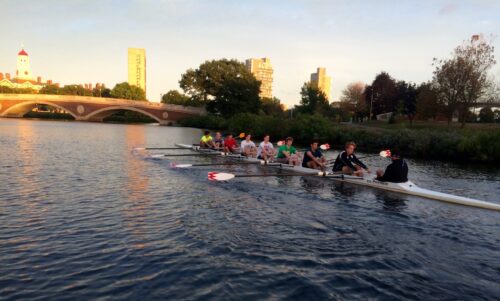Experiencing a world largely dominated by recruits.
Every year, as many as a hundred potential athletes turn up to the crew interest meeting to learn about the nature of the sport, the progression of the season, and the time commitment. Cursory introductions are given as they fill out forms seeking athletic experience, height, and weight. Unlike in high school, the vast majority of college athletes are recruited because many coaches rely on the recruiting process to keep their teams consistently competitive. For this reason, ‘walk-ons’ (non-recruited athletes) are rare, especially in sports with smaller numbers.
One exception is Harvard crew, which prides itself on its strong walk-on program. Men’s Lightweight Coach Ian Accomando states, “Harvard’s walk-on program has always been strong. Harvard rowing, like [in] most schools, was built on walk-ons.” Since most high school students have never had the opportunity to try crew, college is the perfect opportunity for a non-recruited athlete to try his or her hand at rowing.
Maria Splaine’19 had been a swimmer since the age of six and after hearing about the opportunity for crew she attended the interest meeting. Noting the compatibility between the two sports, Splaine claims “swimming for the past 12 years has made me used to brutal workouts so the time commitment is the hardest part, especially with trying to fit in sections.” Furthermore, she finds managing work difficult because, unlike her batch-mates, she doesn’t have the luxury to stay up late studying, and instead has to spend any free time plowing through work.
I am also a crew walk-on. I have been playing tennis since the age of seven and dabbled in baseball, basketball, and volleyball as a multi-sport high school varsity athlete. What attracted me to crew was the tight-knit nature of the team, so I jumped at the opportunity to learn a new sport. My initial expectation was for walk-ons to be sidelined, with attention being focused on the recruits; however, I was pleasantly surprised.
Coach Accomando and Coach Chris Calkins provide constant, energetic feedback during on-water time and offer individual coaching for anyone interested. Accomando also writes up bi-weekly inspirational emails that are sometimes as long as 1,000 words, with embedded video and useful articles links. In one of these emails, he draws a parallel between baseball player Tim Hudson’s climb from the minor leagues and rowing. He emphasizes how Hudson’s success can be attributed to him working on his weakness and practicing changeups, despite his obviously killer splitter. It is important to isolate your weak points. He believes, “If you’re inflexible, don’t erg more, stretch. If you’re the slowest on the stadium, run more and do more jumpies. If you lack body control, start extending the length of the ab circuit if 6min has become too easy, and start doing more push ups and pull ups, and maybe consider going to yoga for extra workouts rather than running [and] erging.”
Accomando describes a strong walk-on as having “strength, stamina, competitive savvy, an intrinsic understanding of leverage, and the capacity to endure extended or repeated rounds of self-inflicted discomfort or pain. A passion for training certainly doesn’t hurt, but a passion for racing is even more desirable. Anyone can do it, they just have to decide to.” Though the crew team doesn’t cut, the process usually sorts things out. In the first two weeks, walk-ons were subjected to two grueling stadium runs (weaving Harvard stadium’s 37 sections). Only half the original number of walk-ons was left standing after this grueling workout. Following this, weekly fitness tests continued until numbers dwindled down enough to fill two boats, approximately.
Despite the success of great walk-on programs at Harvard, Princeton and Cornell, many of the other schools in the league have decided to focus mainly on recruits. Accomando thinks “it’s a real shame, as any alum would tell you, because the walk-ons really bring a certain character to the team that they wouldn’t have otherwise being comprised of only recruits.” Walk-ons are eager and always willing to give their full effort in every rowing lesson and fitness test. They push recruits to do better and exemplify the power of hard work.
Perhaps Harvard’s other sports teams can learn from the inclusivity of the crew walk-on program. Giving walk-ons the chance to train and compete alongside recruits could improve the work ethic of teams as well as connect Harvard sports with the larger student body.
Daniel Um ’19 (danielum@college.harvard.edu) applauds the Harvard crew program and their enlightened methods.

